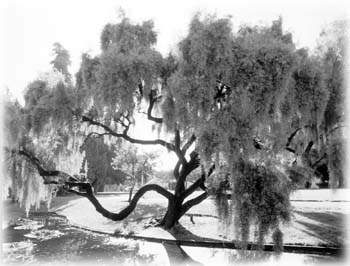![[MetroActive News&Issues]](/gifs/news468.gif)
![[MetroActive News&Issues]](/gifs/news468.gif)
[ Features Index | Sonoma County Independent | MetroActive Central | Archives ]
Faded Jewel
Looks Are Deceiving: The serene beauty of Juilliard Park belies the crack pipes in the restrooms and random violence.
Juilliard Park may get a face-lift
By Paula Harris
LIKE A ROMANTIC English-style garden replete with wooden and stone bridges spanning lily ponds, large beds of roses blooming pink and coral, and cool green expanses of manicured lawn, Juilliard Park shimmers in the sunlight. During this balmy July lunch time, the nine-acre park is a calming pocket within the downtown bustle. Yet on a day that demands walking, snoozing, and lunching al fresco, the park--Santa Rosa's faded crown jewel--is eerily empty as usual.
Horror stories of crime in Juilliard Park--a hangout for derelicts, druggies, and hookers--have not gone unheeded. Now a cooperative effort by neighbors, parks department officials, and local police officers is having a positive effect.
"The perception that [Juilliard Park] is a snake pit is untrue," says Santa Rosa Parks Department Deputy Director Bill Montgomery. "We're working to offset that perception."
In an effort to "take back the neighborhood," Bob and Dee Wishard started the Juilliard Park Neighborhood Watch Association three years ago. The watch covers the corner of Sonoma and Santa Rosa avenues, south A Street where it meets Santa Rosa Avenue, and all of Sonoma Avenue to the freeway, encompassing some 250 households and 30 businesses.
"People say, 'Nothing ever changes,' but it does," Dee Wishard says. "They don't remember what it was like here when finding a used syringe in your yard was a regular occurrence."
Still, she refuses to walk through the park at night. "I've been harassed and propositioned a few times," she explains. "People hide in the park, sleep in the bushes, and blatantly sell drugs. It's scary."
Santa Rosa Police Sgt. Tony Wynne says violent crimes in the park area have declined substantially in the last several years. "Public intoxication, drug dealing, and prostitution have also decreased somewhat, but still occur and we still address them," he says.
Police records show that there were 414 reported incidents, ranging from trivial to a serious stabbing, in Juilliard Park in 1995; 318 reports in 1996; and another 208 during the first six months of this year, up from 165 for the first six months of 1995 and 167 for the first six months of 1996. There were 27 enforcement calls in June 1995, six in June 1996, and 28 last month.
The increase may be reflect increasing vigilance on behalf of the neighbors, Sgt. Wynne says, and greater police presence; neighbors say Wynne encourages officers to write their routine reports in the park, and many residents are on first-name terms with officers.
Residents report relationships with the city have improved since the neighborhood policing strategy began four years ago. "There's a good police response time and graffiti are way down," says resident Edward Halton.
With the recent arrest and subsequent jailing of one drug dealer who had long plagued the park, says Wynne, comes a push to increase such family-oriented activities as a playground and sports courts to displace "undesirables" who have had the run of Juilliard Park.
"The park [which is more of a garden] was never intended for that kind of use, but the city wants to get everyone involved to make a long-lasting impact," says Wynne. "We either have to cement over the park or change the way we use it, because the city is spending a lot of money maintaining the upkeep for a few derelicts."
PARKS DIRECTOR Montgomery estimates it costs $54,000 a year to maintain the park. The site, across the street from the Luther Burbank homestead, once was the showplace home and gardens of C. F. Juilliard (a cousin of the Juilliard family of the famous Juilliard Music Academy in New York), who came to Santa Rosa in 1872 and went into the local wine and fruit brokerage business. In 1931, his son Frederick donated the old Juilliard home site to the city.
With $100,000 in the city budget to upgrade Juilliard Park--a project delayed for two years while the city oversaw the Creek Walk Plan--officials are grappling with making improvements while keeping the park's sense of identity intact.
Montgomery and Park Planner David Kull revealed to residents last week that the city has been toying with ideas of creating in the park a children's play village of Victorian storefronts, or an intricate Small World theme echoing the buildings of Santa Rosa; or a concrete zoo of sculpted animals; or an arbor housing traditional playground equipment.
Although planners favor a non-traditional playground--a "conversation piece befitting the park," says Kull--residents prefer a more active play area. "I'd just like to see the kids out here throwing Frisbees," says Wishard.
Other improvements may include moving the Church of One Tree, now tucked into a remote corner of the park and housing the Ripley Believe It or Not Museum, to a more visible location either at the park entrance or at the corner of Sonoma and Santa Rosa avenues at a cost of up to $3 million; reconfiguring the rose beds and building a bocce ball complex; and replacing a missing waterway bridge.
Montgomery first wants to move the group-picnic area out of the redwood grove, which he says has become a "dark, unattractive hangout." Park rehabilitation plans are in the embryonic stage, and no action will be taken until at least next year if the plans are approved by residents and city officials.
Meanwhile, special events--such as the Arts in the Park concert series and last month's antique auto show--are drawing visitors to the long-neglected park.
"We hope to attract a regular presence of positive use into the park," Montgomery says.
[ Sonoma County Independent | MetroActive Central | Archives ]
Copyright © Metro Publishing Inc. Maintained by Boulevards New Media.

Michael Amsler
From the July 10-16, 1997 issue of the Sonoma County Independent.